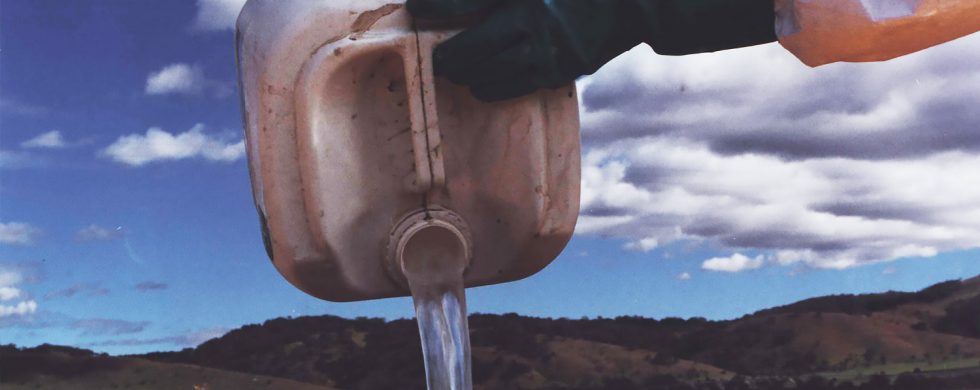The drumMUSTER rinsing standard makes economic sense
Rinsing Options
- Pressure Rinsing
- Using a piercing nozzle
- Probes and ‘sucker flusher’ transfer systems
- Triple rinsing
- Triple rinsing 200L containers
- When you have finished rinsing
Proper rinsing and cleaning are the first steps in safely disposing of empty AgVet chemical containers.
Clean containers are essential for meeting health and safety standards in our processes.
Any rinsing should be carried out immediately after emptying the chemical container, as residues are a lot harder to remove when dry.
Under current regulations in most states, containers that haven’t been properly rinsed can be classified as hazardous waste.
For information on procedures for draining and cleaning oil based, ultra low volume (ULV) and low volume (LV) insecticide sprays, contact the chemical manufacturer or drumMUSTER on (02) 6206 6868.
The drumMUSTER Standard
Inspection of containers at collection points is necessary to ensure that containers can be safely recycled.
- There must be no chemical residue on the inside or the outside of the container, including the thread and cap. If there is any chemical residue visible when delivering your containers these drums will be rejected.
- After rinsing your chemical container it should be left to dry with the cap off which will aid in the drying process.
- The threads of the container opening must be free of residue and although the cap should not be replaced on the container, it may be brought separately to the collection if clean.
- Your container should have the labels on to provide inspectors with identification of the container being handled.
- A signed statement by the farmer or chemical user at the point of the collection provides drumMUSTER with evidence that the container has been rinsed.
- If your container is rejected, the inspector will request that your container is taken home, properly cleaned and returned for recycling in your next delivery.
- When rinsing the chemical container use the rinsate to make up an application of the same chemical according to the products label recommendations.
`
The following table shows the loss of money at three different costs per litre for the product from 150ml, 300ml and 500ml of chemical left behind in containers not thoroughly cleaned.
| Amount of residue | Loss at $20/litre | Loss at $30/litre | Loss at $50/litre |
| 150ml | $3 | $4 | $7 |
| 300ml | $6 | $9 | $15 |
| 500ml | $10 | $15 | $25 |
Pressure Rinsing
Pressure rinsing is one of the most effective forms of cleaning chemical containers. Nozzles are used to spray water into the container; the rinsate is then caught in the hopper and transferred to the spray tank.
Devices are normally built into an induction hopper, (which is attached to the sprayer) or they are purchased as separate induction or filling unit.
It is essential that clean water is used for the rinsing process.
The water pressure should be at least three Bar (300 kPa) and the operation usually takes around 30 seconds and requires around 15 litres of water per 20L container.
Using a piercing nozzle
A special nozzle is attached to the end of a hose to force any remaining chemical from the container. Clean water at a pressure of two to three Bar (200-300 kPa) is required and the following steps should be followed:
- Empty the contents of the container into the spray tank and allow to drain for an extra 30 seconds after the flow reduces to drops.
- Insert the pressure nozzle by puncturing through the lower side of the container and hold the container with the neck pointing down, so the rinsate will run into the spray tank.
- Turn the water on and rinse until the rinsate coming from the container is clear (around 30 seconds) and turn the nozzle to rinse all the inside surfaces.
- Rinse the container cap when there is a clear stream of water coming out of the container.
Probes and ‘sucker flusher’ transfer systems
Several probe designs are available for extracting purposes.
These probes are used to extract the chemical concentrate, enable clean water to enter the container during the process to assist in the removal of viscous products, and, to rinse the container once it is empty.
Probes, which deliver water through nozzles at their base, must be constantly raised and lowered inside the drum and turned from side to side to ensure a thorough cleaning.
Once the contents have been removed with the flushing cycle, repeat the process to rinse the container three times using five to seven litres of water per rinsing (about 15 seconds per rinsing cycle at three bar pressure).
Other probes have a flushing head, which is positioned just inside the neck (at the top of the drum) and a probe, which slides through this fitting or unit to remove the contents.
After the contents have been removed with the flushing cycle, continue flushing the container with 15-20 litres of water.
Triple Rinsing
To achieve a suitable rinse, follow these steps:
- Empty the contents into the spray tank and allow the container to drain for an extra 30 seconds after the flow reduces to drops.
- Fill the container with clean water between 20 and 25 per cent of its capacity and securely replace the cap.
- Shake, rotate, roll or invert the container vigorously for at least 30 seconds, so that the rinse water reaches all inside surfaces.
- Pour the rinsate (the rinsing water from the previous step) into the spray tank and let it drain for an extra 30 seconds after the flow reduces to drops.
- Repeat until the container has been rinsed three times or free of chemical residue.
For your animal dips, add the rinsate to the dip, or medicated water. For animal drenches, dispose of the rinsate in a pit specifically marked and set up for this purpose and ensure it is clear of waterways, vegetation and tree roots.
Triple Rinsing 200L Containers
Cleaning of large 200 litre containers is difficult. It is recommended that two people are available to clean these drums. Our tips on cleaning are:
- Thoroughly drain the container to the lowest possible level
- Fill the container with clean water to 25 per cent capacity and replace and tighten the bungs
- Tip the container on its side and roll back and forth (performing at least one revolution) for 30 seconds
- Stand the container on end and tip back and forth several times to rinse the corners before turning the container to the other end to repeat the procedure
- Carefully empty the rinsate into the spray tank
- Repeat this procedure two more times
- Rinse both bungs in a bucket of clean water and replace them in the container
- Empty the bucket of water used to rinse the bungs into the spray tank
When you have finished rinsing
Follow these steps to complete the cleaning process after rinsing is undertaken:
- Look inside and make sure that all the formulation has been removed.
- Thoroughly clean the thread and outside surfaces of the container with a hose into the spray tank.
- Rinse the cap separately in a bucket of water and pour the rinsate into the tank.
- Inspect the outside of the container (particularly the screw neck and threads) to ensure they are free of any residues.
- Steel containers should be punctured using a steel rod or crowbar; this should be done by passing it through the neck/opening and out through the base of the container.
- To ensure the removal of all rinsate from a container being turned on its side, rock the container to eliminate any trapped liquid. (this is especially important for metal containers!)
- Allow all containers to drain completely and air-dry them (this may take a number of days) to ensure they do not retain any rinse water.
In every case, always make sure that the rinsed containers are drained, free of any chemical residue and allowed to dry.


